Masking the entire board would affect the thermal performance though eh? That’s what these alternative design proposals try to eliminate.
Well, I’m not smart enough to know, but some have said that the junction from emitter to star is the most critical heat path. It does make some sense though, that from the relatively tiny connection point of the emitter, the heat spreads out to an increasingly large area. So, as long as the relatively large outer edge of the board can still conduct heat at least at the same rate overall as the contact area under the emitter, it’s all good, right? Like, if the area under the emitter is 1/10th the area around the rim, then the rim can conduct 1/10th as well and still work fine. I don’t know what the thermal conductivity of solder mask is, so I can’t say if it can do that or not.
Edit: Just for fun, I did some rough calculation. If you consider the entire package size to be the contact area of the emitter, you get 4.41mm² area for the larger Nichia E21A. Supposing a 20mm PCB, and assuming a 1.5mm outside edge contact, you get roughly ~45mm² area. So, like I said, you’d only need the edge of the board to conduct 1/10th as well to be able to carry away the heat as effectively as it is being carried out of the emitter.
I think djozz already came up with the best solution. Battery inserted reversed, battery+ on the entire housing, these Nichias’ anode mounted on the thermal pad (noctigon/sinkpad), connect + and - pads on the board for a cathode; dedicated driver. That beeing said, it’s a dedicated driver what we should consider concerning OSH Park…
Yea that does make sense. I don’t know if it would conduct through the masking 1/10th as well the DTP connection. Comparing high temp epoxies in post #23, there was a 10x difference in thermal conductivity just between two different brands of epoxy. Thermal performance can vary widely among materials.
*Edited for clarity.
Yeah, I just looked up thermal conductivity properties in Engineering Toolbox and the only materials that even come close to 1/10th (or better) are other metals and Diamond.
You could also isolate the MCPCB with a disc of aluminium nitride or something. Aluminium nitride is really interresting for that kind of purposes, but it’s expensive.
Anyone done any testing/measurements with these? I just ordered some 5000K 70cri E21A emitters from futureelectronics and will report any measurements I do.
I ordered some R8000 ones from lumitronics, both 17A and 21A, should be in tomorrow afternoon. I hope to do a test later this week.
Excellent. I’m imagining making my own gapless xhp70 and –50 emitters. Only tests will tell if they can compete in output.
They’re bright and comes in 9080! No tint shift so far.
With XP sinkpad you get oval beam, 2p E21A non isolated, with XM sinkpad you get 4p E21A non isolated. Cathode must be soldered to the MCPCB’s thermal pad. Scrap the masking paint between pads for best result (minimal solder thickness). Also to get the most flat arrays.
Any non conductive thermal pad will do. Best with thin thermal grease on an anodized heatsink.
Yes, 4x 17A should exactly fit an (DTP) XP-pad, all minusses (cathodes) soldered on the thermal pad. The body has become led-minus, a minor problem to solve :party:
And with this one we can get the almost impossible to get: 9080 4500K Nichia
I’ll post my result with 2pcs sm503 and 2 pcs sm303 on a XM DTP board later
It seems there are two ways to deal with the lack of a thermal pad. One way is just to electrically isolate the MCPCB from the flashlight body. As clemence suggested, an anodized shelf with thermal grease should isolate fine, but most shelves are not anodized. Another simple way to electrically isolate the MCPCB is to put a layer of kapton tape around the perimeter of the MCPCB so there is no metal-to-metal contact, then fill the space between shelf and star with thermal paste. Kapton tape is 25-50 microns thick and thermal paste has at least 2 W/mK thermal conductivity, so with a 16mm MCPCB the thermal resistance of the thermal paste is 0.25-0.5 K/W, which is pretty small. Anyway, there are lots of solutions to the problem, but this is the one I was thinking of using.
The other way, as djozz is suggesting, is to electrically connect the flashlight body to the (+) or (-) of the LEDs. I read your description of how to have the LED positive connected to the body, but how would you deal with having the LED negative connected to the body? Putting the driver in the tailcap is one way…
With DTP XM MCPCB it will create a funny beam
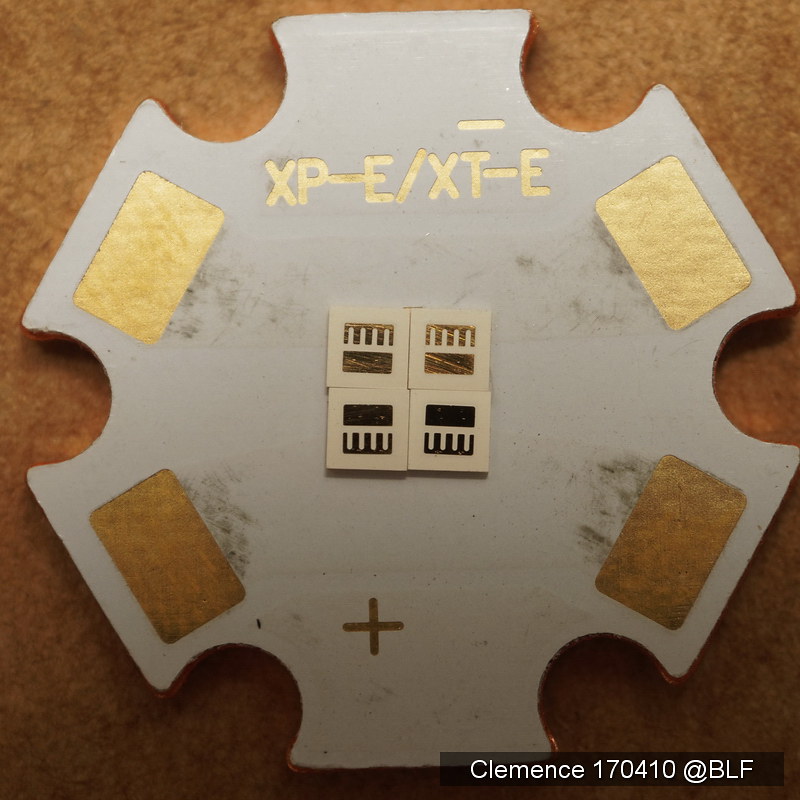
Will be a trending topic with DTP XP MCPCB
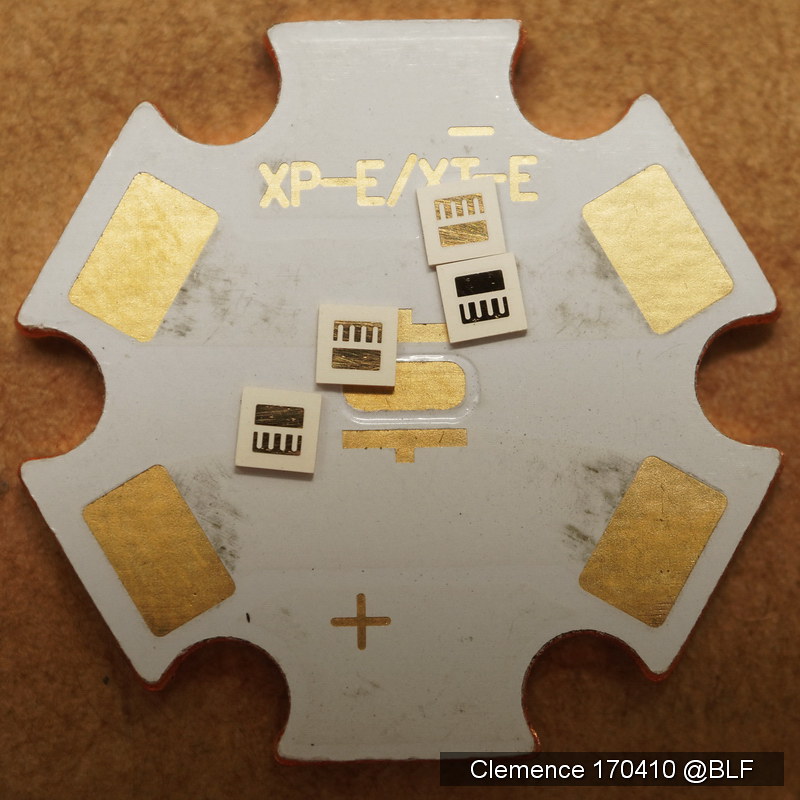
My suggestion is to use DTP aluminum XP MCPCB, then anodize the back side. Easy and straighforward application with existing host.
This will be a very nice 3 Volt class 4,2mm quad die!! With the possibility for tint mixing and individual control.
- Clemence

Eventhough the thermal pad isn't enough for all LEDs to sit on, I gave them a try...
Please don't complain about it, they're tiny, harder to handle, and fly easily. The sm303 9080 is thicker by 0,1mm. Let's see how Djozz handle the smaller E17A later.
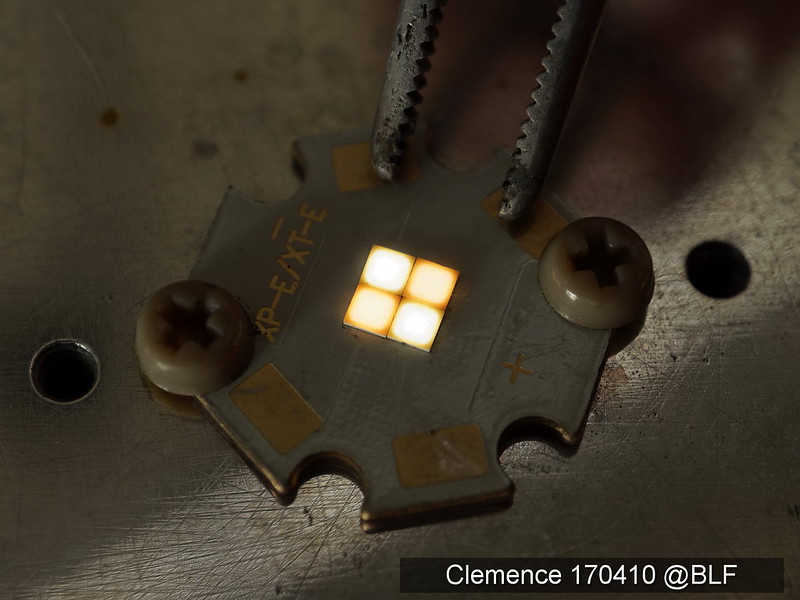
ultra low current by multimeter could lit them all
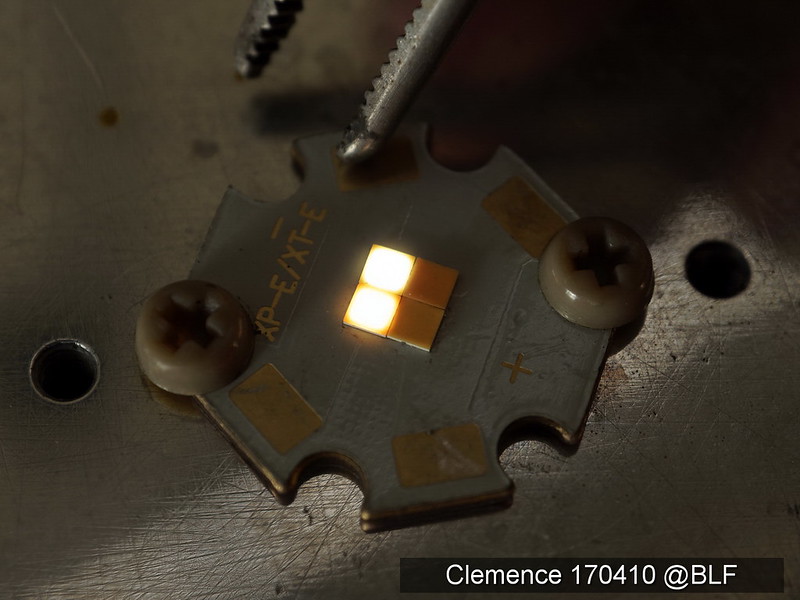
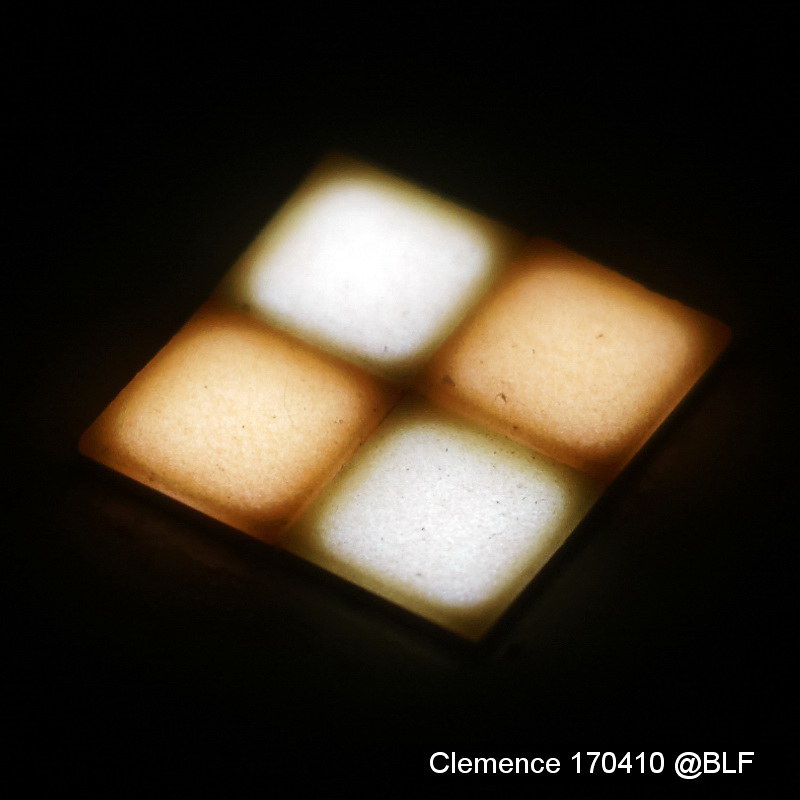
Could be Windows next logo

Gaps, yes I know...

Fits aliexpress XML optics loosely
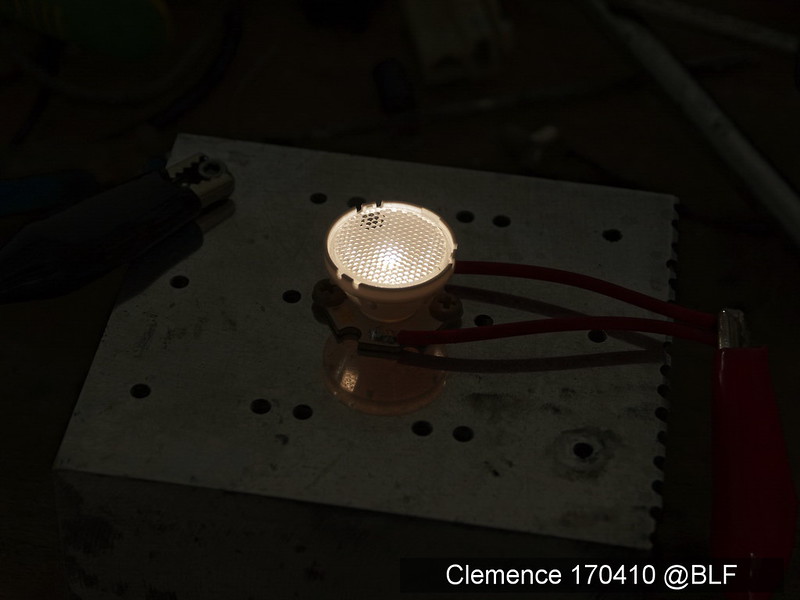
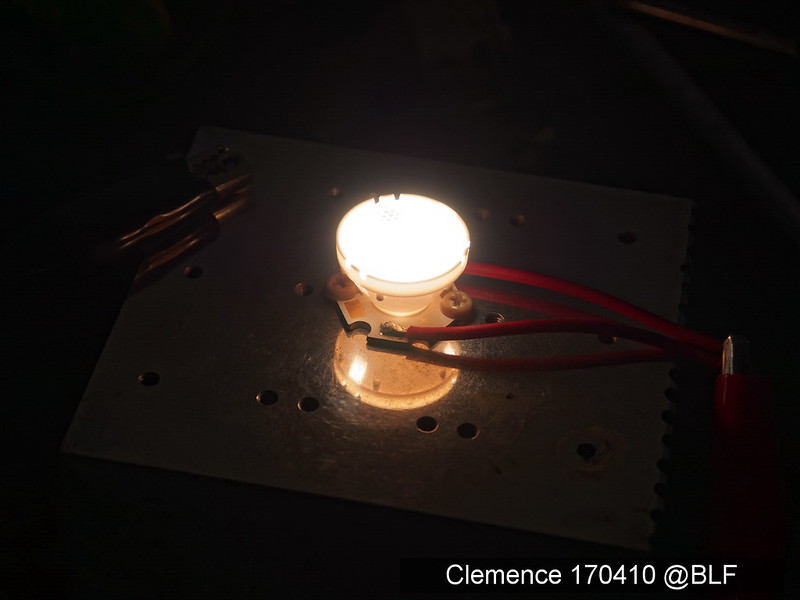
Pleasant 4500K
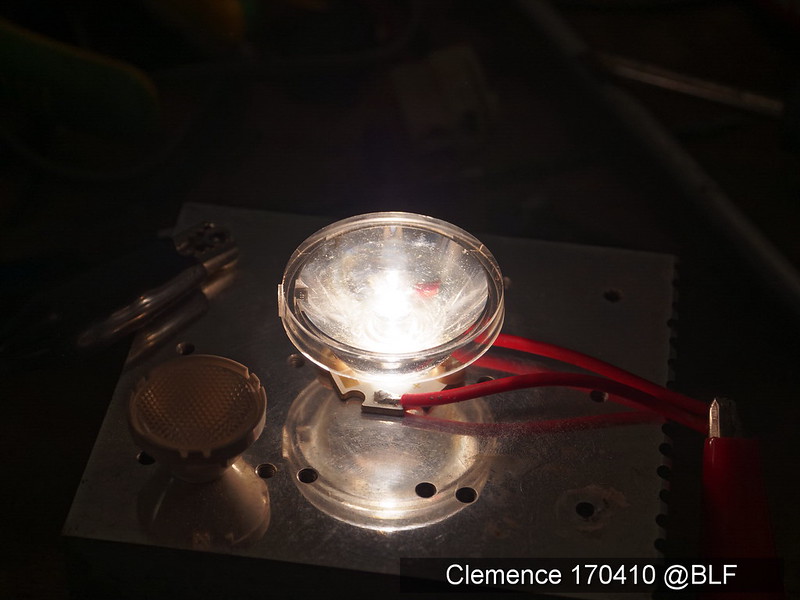

And....pffffffftttt! one dead at 4,6A. With proper MCPCB these should handle up to 8A
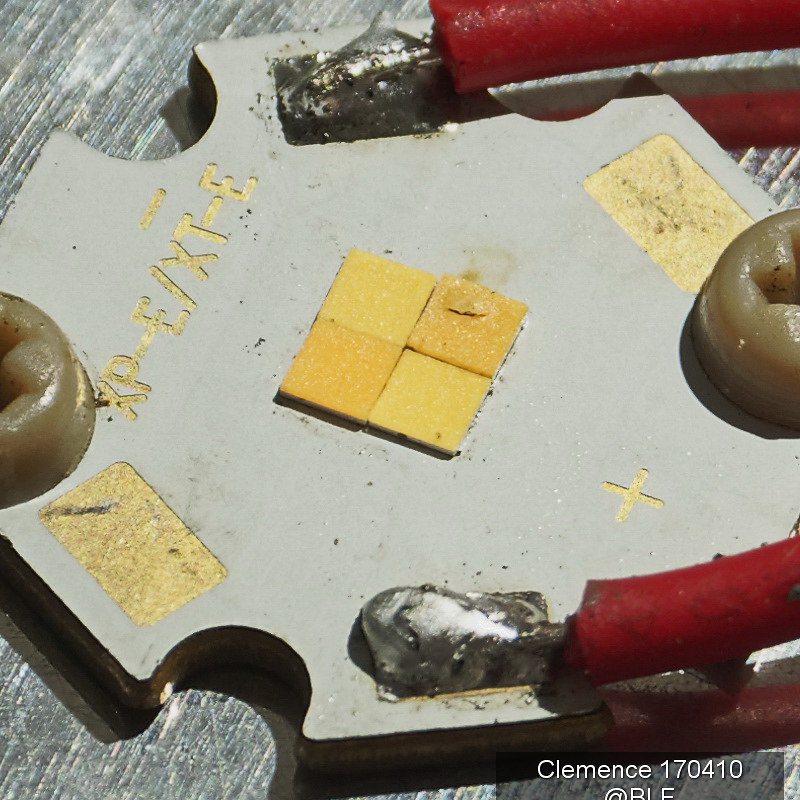
The burns damage all through the MCPCB and short the whole array. Three survived, I'll keep them for later test
Thanks for the nice tests! Pity about the burnt led. At 4.6A that is just 1.15A per led (well, ‘just’ as in the usual BLF expectations). Let’s hope that it handles more current when better mounted.
And that was using the 20mm XP DTP MCPCB with the largest thermal pad. Sinkpad XP has much smaller thermal pad. I guess your E17A will fit better in XP MCPCB
Very interesting test, not sure why I want not subscribed to this thread.
Thanks for the test. That is disappointing; the die doesn’t actually extend to the edge of the package, making it impossible to create a gapless quad.
The gap would be so small as to be unnoticeable in an actual light except for maybe a zoomie I bet.
I am more confused at the early death of the LED myself. Even before the datasheet limits.
